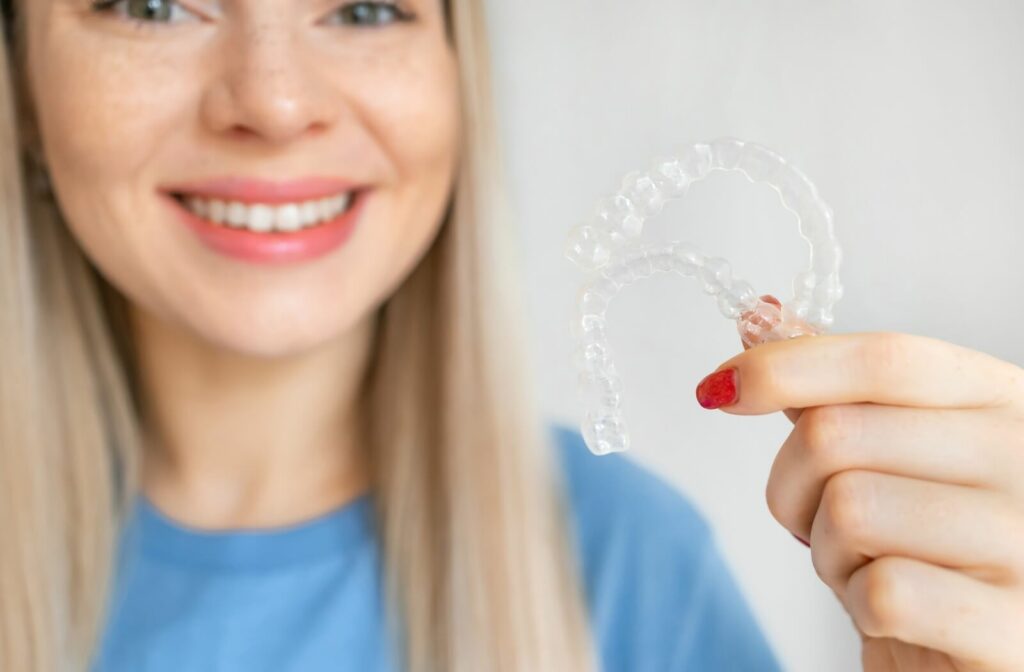An underbite occurs when the lower teeth extend beyond the upper teeth, creating an uneven bite that can affect oral function and appearance.
Fortunately, several treatment options are available to correct an underbite, ranging from Invisalign and braces to expanders and jaw surgery. Modern orthodontic technology, such as clear aligners, often allows for effective, discreet, and noninvasive correction.
Understanding what causes an underbite and how it can be treated is essential for improving oral health, comfort, and confidence.
What Causes an Underbite?
An underbite, also referred to as class III malocclusion, is a type of misalignment that can develop due to several factors.
Common contributors to the development of an underbite include genetics, early childhood habits, and structural misalignments of the jaw or teeth.
Identifying the underlying cause of an underbite can help determine the most effective treatment plan for correcting it.
Genetics
An underbite can develop due to the following genetic factors:
- Jaw size & shape are often inherited, including misalignments
- If a parent has an underbite, their child may have a higher likelihood of developing one
Childhood Habits
Childhood habits that can contribute to jaw misalignment include:
- Thumb sucking, which gradually pushes the lower jaw forward over time
- Extended bottle or pacifier use, which may contribute to improper jaw development
- Mouth breathing caused by nasal congestion can affect tongue posture & jaw positioning
Tooth Misalignment
Your teeth—whether missing or positioned poorly—can affect how your jaw develops:
- Missing teeth or overcrowding may shift the bite out of alignment
- Premature loss of baby teeth can impact the positioning of permanent teeth
Injury or Trauma
Trauma or injury can affect jaw development:
- Facial injuries that impact jaw structure can lead to an underbite
- Jaw fractures that heal incorrectly may result in long-term misalignment
How Underbites & Breathing Are Related
Underbites can be associated with sleep-disordered breathing, which affects both sleep quality and daytime behavior.
An underbite can impact nasal breathing, leading to mouth breathing, which in turn can hinder the further growth of the upper jaw. This disruption can result in symptoms such as teeth grinding, snoring, and loud or labored breathing. Mouth breathing can reduce oxygen intake during sleep, affecting both sleep quality and daytime behavior, often causing fatigue or irritability.
Early intervention to address underbite issues and manage sleep-related breathing concerns can improve breathing patterns, support proper jaw development, and enhance both oral and overall health outcomes for children.
Why Should You Fix an Underbite?
An untreated underbite can lead to dental and jaw-related complications, affecting everyday comfort and long-term oral health.
Potential Issues Caused by an Underbite
An untreated underbite can cause:
- Uneven tooth wear, which can lead to enamel erosion
- Difficulty biting & chewing food, increasing the risk of digestive issues
- Jaw strain & TMJ (temporomandibular joint) discomfort
- Speech difficulties, including lisps or unclear pronunciation
- Aesthetic concerns, such as an altered facial structure
Correcting an underbite can enhance jaw function, improve speech clarity, and promote overall dental health. Treating an underbite can also improve facial symmetry.

How to Fix an Underbite: Treatment Options
Treatment for an underbite depends on its severity, the patient’s age, and the underlying cause. At Bloom Orthodontics, we proudly embrace innovation, providing progressive technology to help kids, teens, and families create healthier smiles.
Invisalign for Underbites
Invisalign clear aligners offer a comfortable, discreet solution for mild to moderate underbites.
The benefits of the Invisalign approach include:
- Custom-made aligners gradually shift teeth into alignment
- Controlled pressure helps reposition the lower jaw over time
- No metal brackets or wires, making treatment more comfortable
- Removable trays allow for improved oral hygiene & easier eating
Invisalign is a convenient, noninvasive option that provides effective results without the discomfort of traditional braces.
SureSmile Clear Aligners
Along with Invisalign, some orthodontic practices offer SureSmile Clear Aligners as an alternative for patients seeking a discreet and effective way to straighten their teeth.
The benefits of SureSmile Clear Aligners include:
- Custom-designed treatment plans for enhanced results
- Comfortable, clear aligners that fit seamlessly over teeth
- Efficient movement that may reduce treatment time
- Removable trays for easier eating & cleaning
For those considering clear aligner therapy, SureSmile is another option that can provide customization and precision in orthodontic care.
Traditional Braces
For moderate to severe underbites, traditional braces with elastics may be required. How traditional braces work:
- Brackets & wires help gradually move the teeth & jaw into proper alignment
- Elastics may be used to adjust jaw positioning over time
- Treatment duration varies, typically lasting 18 months to 3 years
Braces remain a proven option for addressing complex bite issues.
Growth Modification for Children
When an underbite is detected in younger children (typically under 6 years old), growth modification can help guide the upper jaw’s development while they are still growing. One effective method is the use of an oral appliance worn at night, which encourages upper jaw growth and is particularly beneficial for children between 3–6 years old.
Another approach is the use of a palatal expander, which, while not directly correcting an underbite, helps create space for proper tooth alignment and is most effective for children between 7–12 years old. Growth modification helps stimulate the growth of the upper jaw and can reduce the need for more invasive treatments later.
Jaw Surgery for Severe Underbites
Corrective jaw surgery (orthognathic surgery) may be necessary for severe underbites when significant jaw discrepancies exist. Generally, jaw surgery for misalignment issues can:
- Reposition the upper or lower jaw for improved alignment
- Be combined with Invisalign or braces to enhance results
- Require a recovery period while providing long-term correction
Surgery is typically recommended when less invasive methods are insufficient to correct the misalignment.
Why Invisalign Is a Preferred Option for Underbite Treatment
Many patients prefer Invisalign over traditional braces due to its comfort, convenience, and discreet appearance.
Benefits of Invisalign for Underbite Correction
Invisalign has gained popularity among patients of all ages due to its benefits:
- Virtually invisible aligners for a more aesthetic treatment.
- No dietary restrictions, as aligners are removable
- Easier oral hygiene maintenance compared to traditional braces
- Custom-fit digital technology enhances precise alignment
Invisalign enables patients to correct their underbite comfortably and effectively without the inconvenience of metal brackets.
What to Expect During Invisalign Treatment
Invisalign treatment follows a structured process designed to gradually and comfortably shift teeth into proper alignment.
- Initial consultation & digital scan
- A 3D scan maps the teeth & jaw alignment to create a customized treatment plan
- Custom aligners are created
- Aligners are worn for 1–2 weeks per set, gradually shifting teeth into alignment
- Regular checkups
- Every 6–8 weeks, the orthodontist monitors progress & makes adjustments as needed
- Completion & retainers
- Once alignment is achieved, retainers help maintain results & prevent teeth from shifting over time
With proper use and regular checkups, Invisalign can successfully correct underbites while providing a comfortable and discreet treatment experience.
Fix Your Underbite with Invisalign at Bloom Orthodontics
Underbites can impact oral health, comfort, and appearance, but effective treatments are available. Invisalign provides a clear, comfortable, and convenient way to correct an underbite without metal braces or surgery.
At Bloom Orthodontics, we use modern technology, including digital scanning and Invisalign, to create customized treatment plans for each patient.
If you are considering Invisalign for underbite correction, contact us today to schedule a consultation and learn more about your treatment options.



